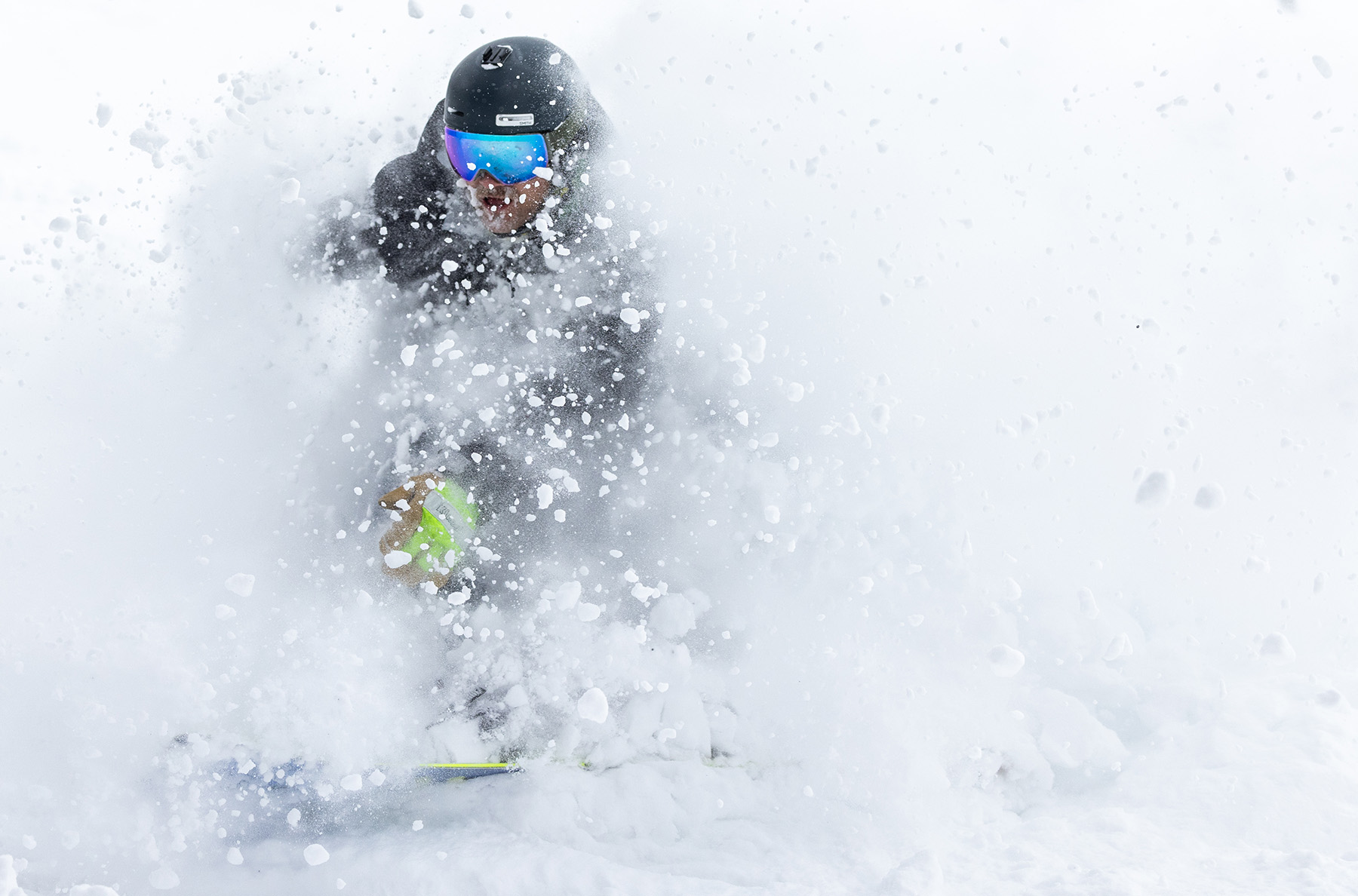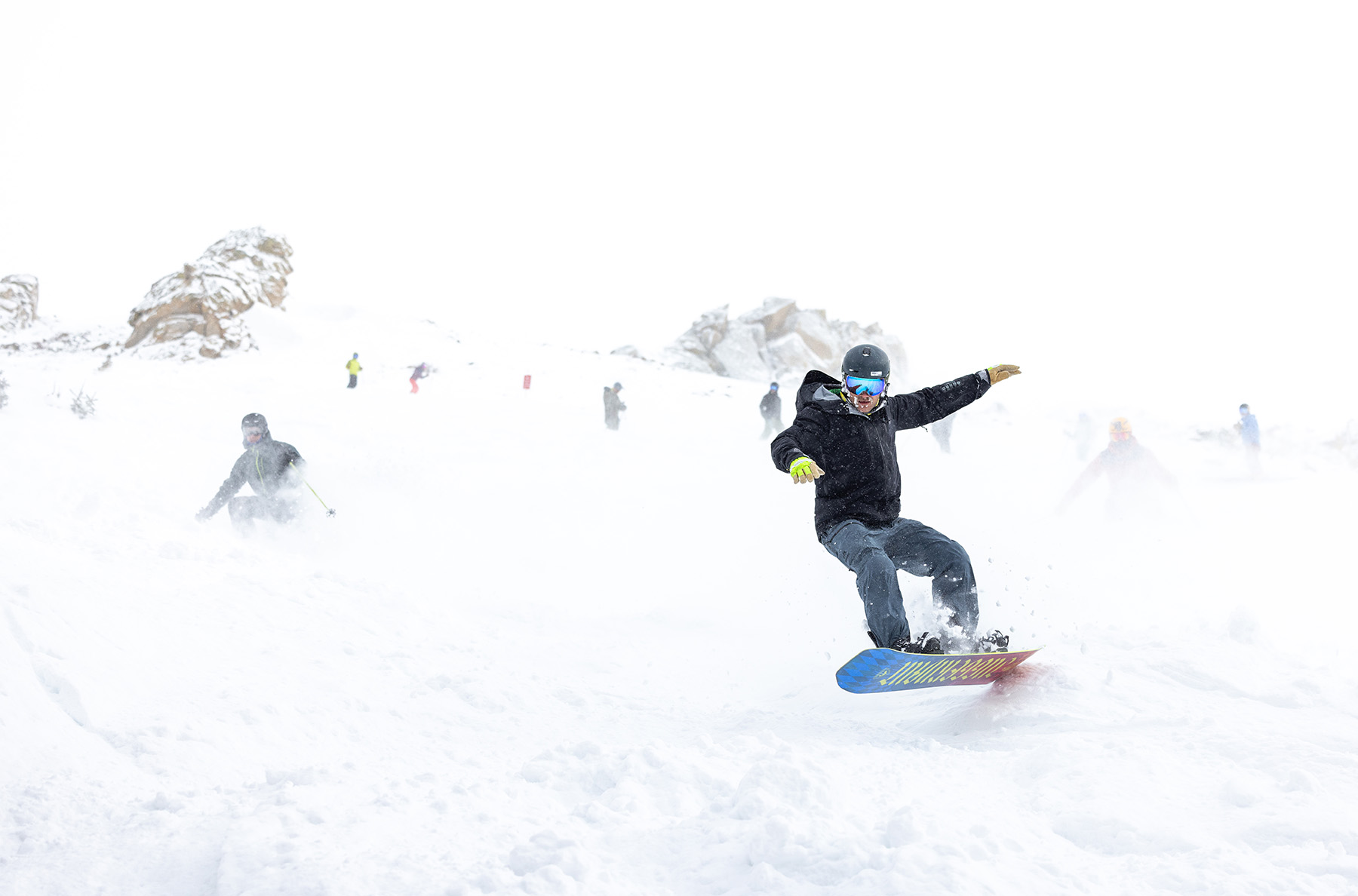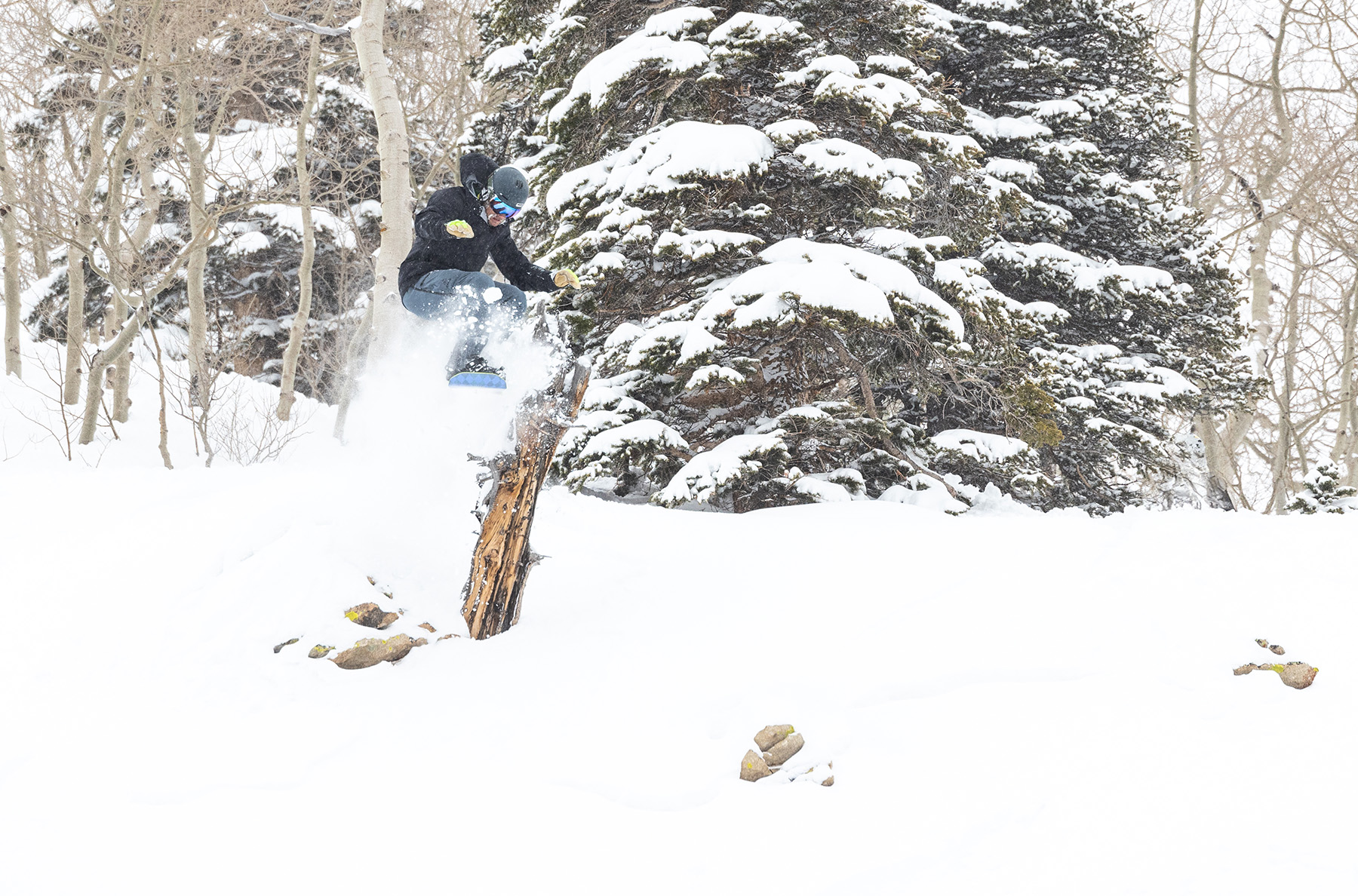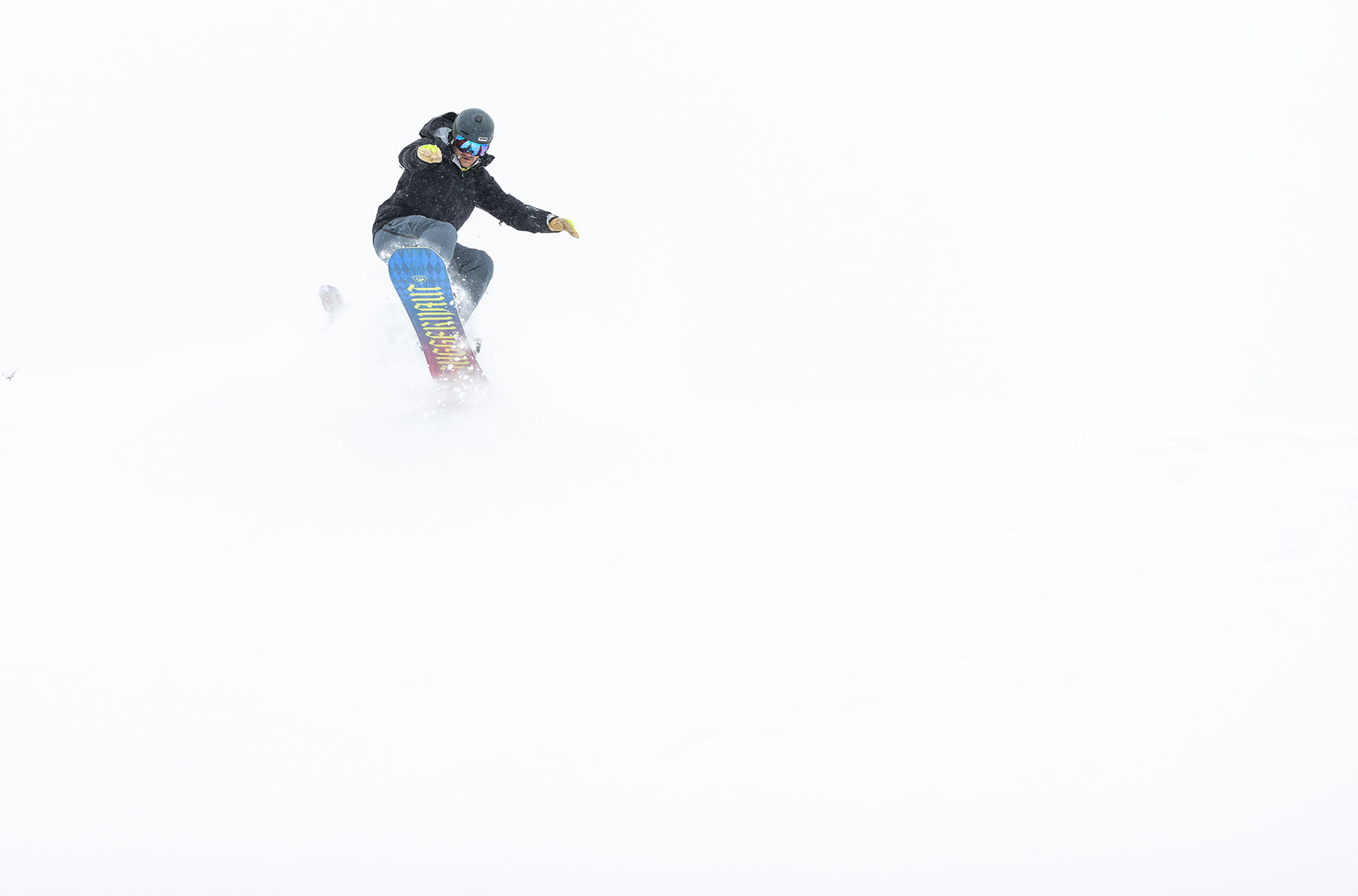Board: 2023-2024 Rossignol Juggernaut, 158 cm
Test Locations: Crested Butte Mountain Resort, CO; Taos Ski Valley & Ski Santa Fe, NM; Timberline, OR
Test Duration: ~30 days
Reviewer (Justin Bobb): 5’ 10”, 175 lbs /180 cm, 79 kg
Available Sizes: 149, 152, 155, 158, 158w, 161w, 162 cm
Blister’s Measured Weight (158 cm): 2.766 kg / 6.09 lbs
Measured Nose-Waist-Tail Widths (158 cm): 298-253-298 mm
Stated Sidecut Radius (158 cm): 6.7/7.3 meters
Camber / Rocker Profile: Amptek Elite (5% tip rocker / 90% camber / 5% tail rocker)
Stated Flex Rating: 9/10
Core Materials: paulownia/poplar + carbon & kevlar stringers + fiberglass laminate
Base: 7500 sintered
Boots Used: Salomon Malamute, K2 Thraxis, K2 Orton
Bindings Used: Now O-Drive, Nidecker Supermatic

Intro
Like many of the larger brands, Rossignol offers a huge collection of boards that cover the full spectrum of riding styles and conditions. The Rossignol Juggernaut falls firmly into the Expert Freestyle category — it’s a stiff, cambered, true twin shape. Its design is meant to maximize precision and pop for big airs and aggressive riding.
Rossignol made some tweaks to the Juggernaut for 23/24 and while we haven’t been on the older version, Rossignol says that “the newer version is slightly softer and without serrated edges,” along with additional size offerings. These changes were meant to make the Juggernaut more accessible to a wider range of riders, beyond elite freestyle pros, while still making it stand out within their lineup as a stout and stable board.
Personally, I typically ride directional all-mountain boards and haven’t been on a true twin in some years. However, I do tend to get along quite well with stiff, mostly cambered models. Based on this background, the folks at Rossignol encouraged me to ride the Juggernaut back at Blister Summit 2023, and I was not disappointed.

What Rossignol Says about the Juggernaut
“The same, but not the same. 2 extra sizes to extend the reach and a new construction that’s slightly thinner to make it smoother to ride while keeping RadCut for laser precision sidecut radius control, Paulownia wood laminates for their high strength to weight ratio and Carbon for explosive pop. The 2023 JUGGERNAUT still sends it but addresses a much broader audience.”
Construction
The updated Juggernaut features a few changes to its core. Namely, it switches to Rossignol’s “Lightwood CK2” core, which features a blend of poplar and lighter paulownia woods, which are combined with carbon and Kevlar stringers, as well as a fiberglass laminate. This core is exclusive to the Juggernaut in Rossignol’s lineup.
[The previous, pre-23/24 Juggernaut used Rossignol’s “L.I.T.E. Wood CBF” core, which used a single type of unspecified, but assumingly heavier, wood that was mixed with basalt and Kevlar fibers in the center.]
The Juggernaut’s carbon and Kevlar fibers are reportedly used “at both the front and the back insert areas, and extend towards the tip, tail and middle section of the board, to offset vertical and horizontal distortion and bring ultimate shock absorption.” Rossignol calls this construction their “Twin Power Box.”
The Juggernaut features a sintered 7500 base, which is generally a fast and durable material used in higher-end boards.
I tend to find rocks pretty easily while riding and I’ve encountered many while riding the Juggernaut. I found the durability of this board to be above average, especially given that it’s not particularly heavy at 2.766 kg / 6.09 lbs for the 158 cm length. A few direct hits following drops / airs resulted in small base scratches but no core shots. I feel confident that this board would last a few seasons under normal resort use, and potentially more if you’re better at avoiding rocks than me.
Shape & Sidecut
The Juggernaut is a true twin, meaning it’s symmetric about the binding inserts. It has a blended sidecut that Rossignol calls “RADCUT,” which is meant to engage / bite better with more speed and more engagement.
This is a combination of traditional sidecut between the inserts that’s blended into reverse-sidecut sections at the ends of the board. The reverse-sidecut sections are subtle and placed symmetrically at the nose and tail. Rossignol says this combo allows for more sidecut to be engaged at higher speeds and higher edge angles, whereas, at lower speeds and edge angles, you’re not engaging as much of the sidecut and the board should therefore feel more maneuverable.
This design also helps create a bit more volume at the tips and tails without narrowing the waist width, in turn keeping quick and responsive edge engagement a priority. The nose and tail are pretty wide (298 mm), relative to the 158 cm version’s 253 mm waist width, which helped to slightly increase flotation and decrease fatigue in powder (more on that below).
For reference, Rossignol lists an average sidecut radius of 6.7/7.3 meters for the 158 cm Juggernaut I’ve been testing. This fairly tight sidecut radius, paired with an overall stiff construction, made this board feel very stable and damp at all speeds, without feeling totally dead or sluggish when carving tighter turns.
Another update to the overall shape of the Juggernaut is the elimination of a serrated sidecut / edge design. The new board’s traditional, non-serrated design was reliable enough to grab deep when needed, but did a good job of maintaining speed while on edge.
The Juggernaut’s nose and tail are also pretty blunted, which makes grabbing and holding much easier and more reliable. It also helps with fun tricks like nose and tail blocks by adding some stability and more contact with the ground.
Camber / Rocker Profile
The Juggernaut is a nearly fully cambered deck. Its version of Rossignol’s “Amptek Elite” profile is the most cambered profile Rossignol offers. The Juggernaut is reportedly 90% cambered; the remaining 10% of the board is rockered, split evening between its tip and tail.

As I alluded to above, I’ve long been a fan of camber-dominant boards, and I was eager to see how the Juggernaut compared to some of my other favorites in that class. From a profile perspective, the Juggernaut’s camber height isn’t as extreme and its contact points are slightly closer to the middle of the board when compared to one of my go-to boards, the Amplid UNW8. I think this is a large part of why the Juggernaut feels slightly more forgiving and offers easier engagement of turns, relative to that board.
Between its camber profile and stiff construction, the Juggernaut has a ton of tension that can be accessed and transformed into pop (though doing so requires effort; more on that below).
The Juggernaut’s slight rocker at the tip and tail is meant to reduce tip and tail catching and help with smoother edge-to-edge transitions. Overall, I think the Juggernaut’s camber-heavy profile + hint of tip and tail rocker makes for a great compromise — you get a little extra lift in soft snow without sacrificing much of the power, stability, and precision provided by the mostly cambered profile.
Flex Pattern
Rossignol rates the Juggernaut’s flex pattern as 9/10 overall and says that it’s symmetrical from tip to tail. From the middle out to its contact points at the tips and tails, the Juggernaut feels quite stiff but not as stiff as the UNW8, which is rated at 8/10 by Amplid. The Juggernaut is likely one of Rossi’s stiffest boards but, from my experience with lots of different stiff boards, I’d probably bump its flex rating down to an 8/10 overall.
Rossignol uses a version of this “Twin Freestyle” flex profile in a lot of their boards, but the Juggernaut is the stiffest board featuring that symmetrical profile. As you move toward its nose and tail, there is a spot just beyond the rocker point where the stiffness seems to decline and soften. This keeps a very small portion of the nose and tail softer for reduced catching and better impact absorption in bumps and chatter. However, the Juggernaut’s overall stiffness makes it feel quite stable, not very chattery, and explosive in terms of pop (at least when you’re able to flex it hard enough).
The space between the Juggernaut’s inserts in the middle of the board also has a subtle difference in flex that I found to really help with torsional rebound in moguls and tight-turn scenarios. It allowed for each end of the board to have some preload and engagement that was independently tied to each foot. This made it feel very snappy while unloading from one turn and engaging the next. Aggressive riders who like to take advantage of features and side hits could come to love the way this board explodes from edge to edge. Despite the stiff flex overall, the Juggernaut’s softer spot in the middle also helps this board pivot around with less effort and less catch than I think it might if it were just as stiff between the inserts.
Now, with all those specs and tech out of the way, let’s get into how the Juggernaut performs on snow:
FULL REVIEW
Powder
This is a true twin in shape, and that doesn’t tend to make powder riding easier (especially relative to directional models). That said, I wouldn’t say the Juggernaut’s shape makes it less fun, though that’ll depend on your own preferences.
I found that setting the stance back on the Juggernaut, in some cases as far back as possible, was necessary for my preferences. Compared to directional boards, it simply takes more work to ride a true twin in deep powder and can fatigue the back leg throughout the day.
(For reference, when I say “as far back as possible,” this was 4 cm back from a centered reference stance at my go-to width of 54 cm; the 158 cm board offers a min / max stance width of 51-63 cm.)
When riding the Juggernaut in fresh snow, more speed meant more float and less effort overall — it’s not ideal for noodling through tight trees at slow speeds but can be a blast when pushing it harder, especially if you can also find some air time. This board is similar to the Amplid UNW8 in that it will give back what you put in. Being able to access the pop and responsiveness of these stiff, cambered boards can result in a very aggressive yet playful ride. But it also takes effort and determination to make the most of their stout flex patterns.

I also think that folks who like to build jumps in the backcountry could love this board (as a snow-machine-access backcountry deck). The Juggernaut made it easy to stomp landings due to its volume in the nose and tail, supportive flex pattern, and quick engagement of the edges, between its camber and tight sidecut. It’s far from an ideal pow-specific board, especially in tighter terrain and at lower speeds, but it can be really fun in certain pow-day scenarios.
Soft Chop and Tracked Pow
I feel that this board truly came alive and started to shine in choppy and tracked pow. In these conditions, its freestyle twin shape allowed for a very playful feel, yet its stout flex pattern and cambered profile maintained stability and composure. I was tempted to try things I haven’t in a while, partially due to having a true twin attached to my feet, but also because the Juggernaut’s playfulness felt more accessible than the Amplid UNW8 that I’ve ridden for years (and is the most directly comparable board that I’ve been on).
The Juggernaut is just slightly less cambered overall and a bit softer in the middle, whereas the UNW8 is very stiff throughout. The Juggernaut’s “soft spot” in the middle, which isn’t actually that soft in the grand scheme but is easier to flex than the area outside the inserts, allowed for easier engagement of the back foot when flotation was needed but also allowed for brief periods of relaxation.
In New Mexico, we generally get fairly dry conditions and storms often come in small increments. The Juggernaut’s blunted nose helped it float pretty well in our soft snow and blast through most of the piles of cut-up and pushed-around snow. It is a powerful board and responds well to powerful input from the rider. However, when I was putting in that input, I was still able to shut down speed very quickly and confidently in steeps and uneven terrain.
Crud and Variable Conditions
This board handled extremely well in what many folks would call adverse conditions. Personally, I love variable snow and think of it as an opportunity to expand my views on what “good conditions” are or can be. The Juggernaut is a capable board for most resort riding and I therefore used it in just about all the conditions I encountered over 30+ days of testing. Given that, there will inevitably be some harder conditions that require attention and input to confidently get through.

Thanks to its camber, quick edge engagement, and overall stiffness, this board performed very well in chattery and hard conditions. Being a true twin, you’ve got equal-sized tips and tails to rely on when you need to promptly shut down speed, without having to weight the board unevenly. Overall, the Juggernaut feels very damp and very precise, which translates to confidence for me and riders who generally can / want to ride aggressively. That said, anyone who isn’t used to engaging stiff, fully cambered boards may want to look for a softer board with more rocker, since those traits will generally make boards more forgiving at lower speeds (but also less precise and composed when really pushing them).
Moguls & Tight Terrain
I have mentioned before how much I love moguls and the Juggernaut and I have gotten along quite well in bumps for the same reasons that I think it performs well in harder, rougher snow. Its symmetric shape allowed me to drive it downhill / with my front foot while simultaneously loading it up / bending it in the troughs. As a result, I was able to explode out of turns, fairly easily gap moguls, and land with confidence in the next trough, already preloaded for the next turn. It’s torsionally stiff but not so stiff that I wasn’t able to start moving my front foot into a turn slightly ahead of the back foot.
Riders who seek out airs, gaps, and transitions to link up in moguls would likely love this board. However, as mentioned above, doing so on the Juggernaut requires a fairly high-speed, aggressive approach. Its stiff flex can help deal with hard landings and harsh snow, but it also makes it harder to flex through the troughs. A softer board would make more sense for riders looking to carve the troughs and stay more connected to the ground at slower speeds.
Park / Freestyle
This board is designed with big jumps in mind. Unsurprisingly, it performs really well in that arena while also being a versatile 1-board quiver for aggressive freestyle riders, with the caveat of its true twin shape and corresponding limitations in powder.
The Juggernaut’s pop is something that can be accessed on bigger features and results in lots of air time and stable landings. Its stiff flex pattern doesn’t make pressing or buttering very easy, although it is still possible (in part thanks to the softer sections at the very ends of its tips and tails). Due to its stout flex, popping out of presses and butters can be explosive and surprising, especially at first. While the board softens just past the (short) rocker point, the vast majority of its length is still quite stiff and engaged when you bend it, resulting in serious tension release / rebound when it’s unloaded.


The Juggernaut’s design traits pair well with park jumps and pipes of all sizes, but it’s less ideal for pressing on rails and boxes. It will handle large landings with precision and performs quite well in icy park conditions. I’d expect to see this board on the biggest features in the biggest parks, but would be more surprised to see many people loving it in smaller, slower-speed park setups.
Groomers
The Juggernaut can cut deep, tight turns at slow and fast speeds on piste. I didn’t notice an upper limit to its precision and composure on groomers and felt confident digging in the edges in a wide range of conditions.
It wouldn’t be a top pick for a dedicated “freecarving” setup because it’s still somewhat narrow in the waist, introducing a higher potential for toe / heel drag. And because it’s a true twin, it doesn’t have the nose length that really helps during deep carves by creating a platform to support a lot of forward, down-the-slope pressure. Still, it was lots of fun for cutting hard turns on piste while also riding a variety of terrain throughout the day. Its short-ish sidecut radius also helps in park and pipe scenarios when you need to make small adjustment turns.
When making these sort of tight, carved turns, similar to what I said about it in moguls and chop, the Juggernaut really wants to get loaded and unloaded in a rhythm. Again, doing so requires effort and could be tiring, but when I put in the work and stayed in that rhythm, its poppy flex pattern and cambered profile made for very quick edge-to-edge transitions. Although we never tested the previous Juggernaut, the elimination of its serrated sidecut / edges is likely a welcome change for those looking to extract as much speed as possible, and/or who just prefer the smoother feel of boards with traditional, non-serrated sidecut designs.
Comparisons
As I noted at the outset of this review, I’ve spent most of my recent years on directional boards, so my specific comparisons are a bit limited for the time being. However, we’re hoping to review more boards in the Juggernaut’s class in the future.
Rossignol Juggernaut vs. Amplid UNW8
Although the UNW8 isn’t a true twin in the “freestyle” category, there is lots of overlap here in terms of flex and camber profile, which makes it a worthy comparison. The UNW8, like the Juggernaut, is designed for expert riders who want to extract as much speed and pop from the mountain as possible.
The Juggernaut, though still designed for expert riders, is more accessible and versatile than the UNW8. The Juggernaut is slightly softer and a little lighter, making it a bit easier to maneuver overall. It bit of tip and tail rocker also helps reduce catching in variable snow. Between the Juggernaut’s bit of tip rocker and the slightly setback stance on the directional UNW8, I didn’t notice a big difference between the two when it came to performance in powder.
In the end, the Juggernaut is a bit more freestyle-friendly and a bit more accessible / maneuverable, whereas the UNW8 might be more intuitive for some directional riders, or just for those who want an even stiffer, more cambered alternative to the Juggernaut.
Rossignol Juggernaut vs. Capita The Outsiders
The Capita “The Outsiders” is another cambered board with a small amount of rocker at the nose and tail. Compared to the Juggernaut, The Outsiders is a softer board and would better fit riders who want to ride rails in the park with a more forgiving flex for presses and board slides. The Outsiders doesn’t offer as much pop / rebound as the Juggernaut, but The Outsiders’ pop is easier to access and load up. Although softer than the Juggernaut, I wouldn’t say The Outsiders board is particularly soft within the whole market and still fits well into the expert freestyle category.

Rossignol Juggernaut vs. Salomon Huck Knife Pro
In terms of on-paper specs, the Huck Knife Pro and Juggernaut are probably the most comparable of the boards with which I’m familiar. Unfortunately, I haven’t yet been on the Huck Knife Pro, but I hope to make the on-snow comparison in the future. In the meantime, I figured it’d be worth at least discussing their on-paper differences as a placeholder.
They both are true twins with blunted nose profiles and are on the stiffest end of each company’s scales. Both are designed for huge features in the park and mining side hits for all the available airtime. Both also use carbon in their builds and apply each brand’s highest-end materials. Even their tip-waist-tail dimensions are eerily similar. The Juggernaut’s camber may be more exaggerated and it also has a slightly smaller stated sidecut radius.
We’re eager to try the Huck Knife Pro in the future and report back — if any of you happen to have tried both, feel free to let us know in the comments!
Who’s It For?
The Juggernaut has a lot to offer to anyone who is willing and capable of putting in the effort to access that potential. Overall, it’s most ideal for expert park riders looking to go big and land hard, but as evidenced by how much I’ve come to enjoy it, less freestyle-specific folks can also enjoy it.
I think the Juggernaut is forgiving enough to be ridden by solid intermediate riders and may help move their progression forward to bigger jumps, but I could also see it being frustrating and demanding for some riders who are timid or don’t tend to go fast.
This board also wants to be in the air. Although it performs very well in most conditions and terrain, it really excels on big jumps and is, overall, a stiff, freestyle-oriented platform. If you don’t want to ride / land switch and/or don’t plan on spinning or flipping very often, you might be better served by more directional models. But if you have at least some interest in airs and tricks, like to ride aggressively in the resort, and won’t be frequently using it in deep powder, the Juggernaut is definitely worth a try. It pushed me to spin more, do so with more confidence, and go bigger than I have on jumps in recent years.
That freestyle caveat aside, the Juggernaut is a pretty versatile all-mountain board for folks who prioritize power, precision, pop, and stability — and who are willing to work a little harder to make the most of the board. The Juggernaut’s main weak point is found in deep snow, where it’s more fatiguing to ride than more directional alternatives, but in most other conditions and terrain, it’s a very stable, lively, and responsive board that aggressive riders could love.
Bottom Line
The redesigned Rossignol Juggernaut is an export-oriented freestyle board that stays true to its design goals in terms of its exceptional stability, pop, and high-speed performance in a relatively lightweight package, while also introducing a few design changes to make these elements a bit more accessible to a wider range of riders.
It’s still a pretty game-on board, but for fans of stiff, cambered models who are curious about that combo in a true-twin all-mountain shape, the Juggernaut is something special.


